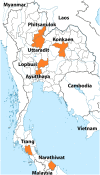The Success of a Universal Hepatitis B Immunization Program as Part of Thailand's EPI after 22 Years' Implementation
- PMID: 26938736
- PMCID: PMC4777547
- DOI: 10.1371/journal.pone.0150499
The Success of a Universal Hepatitis B Immunization Program as Part of Thailand's EPI after 22 Years' Implementation
Abstract
Hepatitis B vaccination for newborns was introduced in two provinces in 1988 as part of Thailand's Expanded Program on Immunization (EPI), and extended to the whole country in 1992. Our previous studies showed that children and adolescents who were born after the implementation of this program had a carrier rate of less than 1%, compared with 5-6% before implementation. In 2014 we performed hepatitis B serosurveys among 5964 subjects in the different geographic regions of the country to evaluate the long-term immunogenicity and impact of universal hepatitis B vaccination in newborns as part of the 22-year EPI program, by assessing HBsAg, anti-HBc and anti-HBs seropositivity status. The number of HB virus (HBV) carriers, both children and young adults, who were born after universal HB vaccination was markedly reduced. The carrier rates among the age groups 6 months to 5 years, 5-10, 11-20, 21-30, 31-40, 41-50 and >50 years were respectively 0.1, 0.29, 0.69, 3.12, 3.78, 4.67 and 5.99%. The seropositivity rate for HBsAg in the post-EPI group was 0.6%, whereas in the pre-EPI group it was as high as 4.5% (p<0.001). HBV infection by means of detectable anti-HBc had also drastically declined in the population born after the HB vaccine was integrated into the EPI program. We estimated that the total number of HBV carriers amounted to 2.22 million, or 3.48% of the total population, most of whom are adults. The HB vaccine is the first vaccine shown to be effective in preventing the occurrence of chronic liver disease and hepatocellular carcinoma. Universal vaccination campaign will contribute to the eventual eradication of HBV-associated disease.
Conflict of interest statement
Figures








References
-
- WHO. Department of Communicable Diseases Surveillance and Response. Hepatitis B. 2002. Available from: URL: http://www.who.int/csr/disease/hepatitis/HepatitisB_whocdscsrlyo2002_2.pdf.
-
- Hyams KC. Risks of chronicity following acute hepatitis B virus infection: a review. Clin Infect Dis. 1995;20(4): 992–1000. . - PubMed
-
- Chang MH. Natural history of hepatitis B virus infection in children. J Gastroenterol Hepatol. 2000;15 . - PubMed
Publication types
MeSH terms
Substances
LinkOut - more resources
Full Text Sources
Other Literature Sources
Medical

